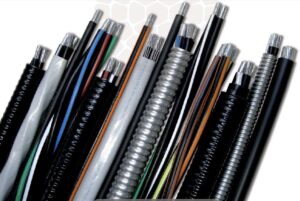The New Aluminum Wiring

The “New” Aluminum Wiring
When a home inspector hears the words “Aluminum branch circuit wiring in solid conductor
sizes 14. 12. or 10 AWG”, we usually cringe. Everyone is aware of the fires associated with certain types of Aluminum wiring. In the late 1960’s until the mid 1970’s aluminum was used to wire entire houses. This was mostly due to the high price of copper. Receptacles, switches and electrical devices were not designed with the specific properties and requirements of aluminum. The terminations at these devices, over time began to fail due to improper connection type and dissimilar metal corrosion. The connections between the steel screws and aluminum wire became loose due to the heating and cooling (load cycling) of the circuit. Also something know as “creep”, which is a property of all metals. Creep is the measurement of the rate of change of a materials dimension over a period of time when exposed to a force at a particular temperature. Old aluminum wire had a higher creep rate than copper. The difference in creep rate between the steel screws and aluminum resulted in overheated connection failures, that in some cases caused fires. Devices labeled CU/AL were manufactured and were supposed to address this problem; however they did not and were replaced with devices labeled CU/ALR (copper-aluminum, Revised). These devices have screw terminals that have deeper undercuts and use an alloy that closely mimics the characteristics of aluminum. The CU/ARL designation is for branch circuits. CU/AL is still used for large conductors including main service conductors. Most home inspectors report any solid core aluminum branch circuits in sizes 14, 12, and 10 AWG as a potential defect. Recently, The American Society of Home Inspectors (ASHI) has removed the requirement to describe solid conductor aluminum wiring because, according to ASHI it is inconsistent with other SOP sections, in that the existing requirement singles out a specific component for special reporting and simply notifying the client about the presence can create concern where none should exist. Many home inspectors do not agree with this.
So what about the “new aluminum”, and how can we tell the difference, and properly advise our clients? MORE
Metallurgists developed an aluminum alloy that possesses different characteristics from the “old” aluminum and more closely resembles the characteristics of copper. So what should a home inspector be looking for when they see aluminum wiring, and how should they advise their client:
- If you see aluminum branch circuit wire (like copper wire) it should be identified in your report
- 14 AWG aluminum branch circuit wire is not recommended
- 12, and 10 AWG aluminum branch circuit wire should be stamped with the following: AA-8000, AA-8176, or AA-8_ _ _ (followed by 3 other digits)
- AA-8000 is “compact stranded” as can be seen from the photo at the beginning of the article, not solid core.
- If you see AA-1350 – this is the old style aluminum wire and should be reported as a potential fire hazard if improper connections exist.
- Receptacles and switches marked CU/ALR should be used with smaller sized aluminum branch circuit wiring
- Larger conductors including main service conductors should be connected to devices labeled CU/AL
- Any arcing, scorching, or loose connections should be reported
Although some organizations do not require home inspectors to report on aluminum branch circuits, many do. New York State Home Inspector Standards of Practice Section 197-5.9; Electrical System (b) (3) state: “Home inspections shall describe readily accessible and observable portions of: 3. The presence of aluminum branch circuit wiring”.
It would be impossible to trace all the aluminum branch circuit wiring to ensure proper connections, and devices were used. It is my belief that your client should be advised to have a licensed electrician examine the aluminum branch circuits and terminations to ensure proper connections have been made and a fire hazard does not exist.
Reference NEC table 310.16 that details specific types of conductors and allowable ampacities.
Related Articles
- Inspecting Branch Circuit Wiring Runs
- The Difference Between Electric Service Grounding
- Zinsco Electric Panels
- Reporting on 2 Slot Ungrounded receptacles
Want To Learn More? Click HERE to Search Our Full Database Of Home Inspector Newsletters.
Brought to you by InspectCheck
Try InspectCheck for free at https://www.InspectCheck.net/pricing/
